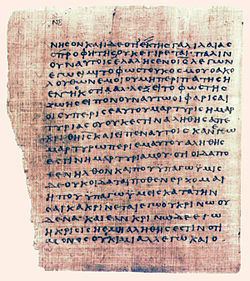Name P. Bodmer II | Found Jabal Abu Mana, Egypt | |
 | ||
Text John 1:1-6:11; 6:35-14:26,29-30; 15:2-26; 16:2-4,6-7; 16:10-20:20,22-23; 20:25-21:9,12,17 Date about AD 200 (Martin), AD 100-150 (Hunger), "early or middle fourth century" (Nongbri) Cite Martin, Victor. Papyrus Bodmer II: Évangile de Jean 1-14 (1956); Martin, Victor. Papyrus Bodmer II: Évangile de Jean 14-21 (1958); Martin, Victor and Barns, J.W.B. Papyrus Bodmer II: Supplément, Évangile de Jean 14-21 (1962); Aland, Kurt. "Neue neutestamentliche Papyri III" NTS 20 (1974) pp. 357-381; Hunger, Herbert. "Zur Datierung des Papyrus Bodmer II (P66)," Anzeiger der Österreichischen Akademie der Wissenschaften philosophisch-historische Klasse 97 (1961) 12–23; Nongbri, Brent. "The Limits of Palaeographic Dating of Literary Papyri: Some Observations on the Date and Provenance of P.Bodmer II (P66)," Museum Helveticum 71 (2014), 1-35. Similar Papyrus 75, Papyrus 46, Rylands Library Papyrus, Chester Beatty Papyri, Papyrus 9 | ||
Papyrus 66 (also referred to as
Contents
Description
The manuscript contains John 1:1-6:11, 6:35b-14:26, 29-30; 15:2-26; 16:2-4, 6-7; 16:10-20:20, 22-23; 20:25-21:9, 12, 17. It is one of the oldest well-preserved New Testament manuscripts known to exist. Its original editor assigned the codex to the early third century, or around AD 200, on the basis of the style of handwriting in the codex. Herbert Hunger later claimed that the handwriting should be dated to an earlier period in the middle or early part of the second century. More recently, Brent Nongbri has produced a broader study of the codex and argued that when one takes into consideration the format, construction techniques, and provenance of the codex along with the handwriting, it is more reasonable to conclude that the codex was produced "in the early or middle part of the fourth century."
In common with both the other surviving early papyri of John's Gospel; P45 (apparently), P75, and most New Testament uncials, Papyrus 66 does not include the pericope of the adulteress (7:53-8:11); demonstrating the absence of this passage in all the surviving early witnesses of the Gospel of John. The manuscript also contains, consistently, the use of Nomina Sacra.
Studies done by Karyn Berner and Philip Comfort, contended that
The staurogram appears in at least ten places in the papyrus (corresponding to chapter 19 of the Gospel).
Text
The Greek text of this codex is a representative of the Alexandrian text-type. Aland ascribed it as "Free text" and placed it in I Category.
A transcription of every single page of
History
The manuscript was found in 1952 at Jabal Abu Mana near Dishna (Egypt). In fact, the preservation level of
It was published in 1956 and it was the most important New Testament manuscript publication since the Chester Beatty Papyri in 1933-1934.
It is currently housed at the Cologny-Geneva, Switzerland: Bibliotheca Bodmeriana. The Papyrus contains 39 folios - that is 78 leaves, 156 pages - at a size of 14.2 cm x 16.2 cm for each leaf with roughly 15-25 lines per page.
